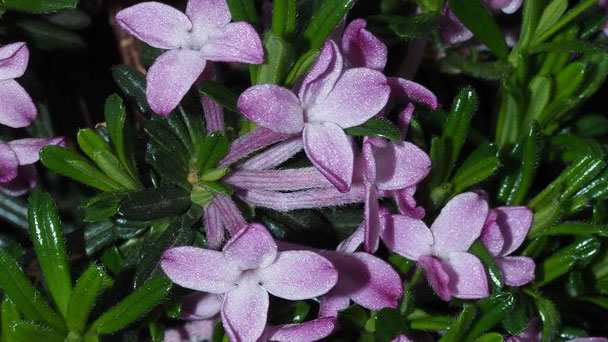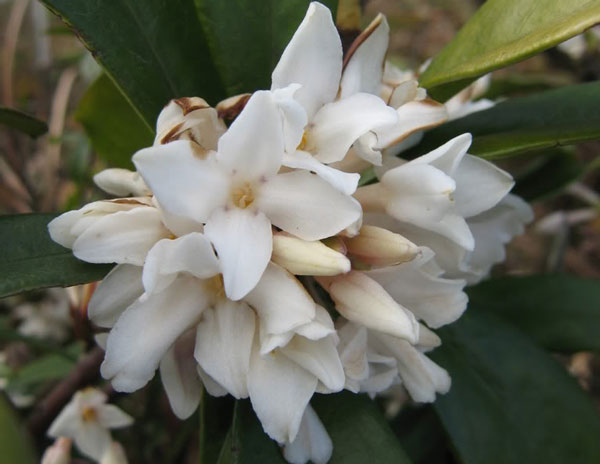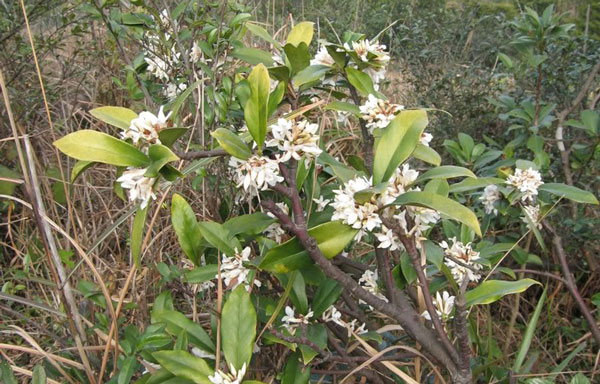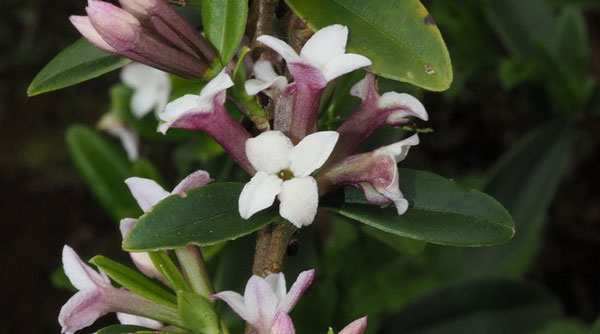Daphne Plant: How to Grow & Care for Daphne Shrubs
Written by Iris
Nov 22 2021

Daphne plant is a beautiful flowering shrub that is one of the best plant choices to benefit all year round. Daphne plant is well-known for its early flowering, and it is often the highlight of overcast days, even in winter. Daphne plant is reliable for butterflies, bees and other pollinators. The favorite aspect of the gardeners who grow this plant is the scent of the flowers; Small clusters can really fill a space with fragrance.
If this is not possible a pot is the next best alternative. When potting a daphne plant, put some plastic fly-wire over the drainage hole in the bottom of the pot. This is not for any horticultural reason, but to stop soil from leaching out of the drainage hole with each watering. Then add the potting mix, selecting a potting mix that meets the Australian Standard. It is a good idea to add a little peat moss to your mix to improve drainage and water-holding capacity of the mix.
With cuttings, start with around a 6-inch branch from an existing, healthy shrub. Dip the cutting into a rooting hormone, and then plant in a pot with rich soil and compost. Keep the cutting lightly watered for the next couple of months. You can gently tug on the cutting after a few weeks to see if roots are established. Then you can try transplanting it to its permanent location in a shady area.
Occasionally daphne plant may develop yellow leaves. Possible causes include a deficiency of a trace element, magnesium (Mg). This can be fixed with Epsom Salts. Dissolve a level tablespoon in 4L of water in a watering can and sprinkle over the root system.
A yearly application of iron chelates (as per label directions) after flowering may also be beneficial to the overall health of the plant.
Be careful since this bush never responds well to too much pruning, which may lead to its death. Your job is to use pruning shears and cut off damaged branches and the parts of the plant affected by the disease.
When you prune the tips of the new, longer shoots, you will help your plant to thrive and become fuller. However, take care not to cut parts crucial for blooming.
On more alkaline soils, yellowing of the foliage due to nutrient deficiency may be remedied by application of chelated iron, such as sequestrine.

Daphne that get too much direct sun can start to get discolouration on their leaves, so keep the plants in a party-shaded area – near a fence line, at the back of the house, or wherever there is mottled light.
The most common reason daphne leaves turn yellow is chlorosis. Remedy this by using a tonic such as Sequestron. A good feeding regime will mean chlorosis is less likely to occur.
Read Next:
Best 15 Winter Flowers for Winter Garden
Where to Grow Daphne PlantHow to Grow Daphne PlantDaphne Plant Propagation with SeedsDaphne Plant Propagation with CuttingsDaphne Plant Propagation with GraftingHow to Care for Daphne PlantDaphne Plant Lighting RequirementsDaphne Plant Soil CareDaphne Plant WateringDaphne Plant Temperature & Humidity CareDaphne Plant FertilizerPruning Daphne PlantDaphne Plant Pests & Diseases CareVarieties of Daphne PlantDaphne Plant Care FAQWhy My Daphne Plant Have Yellowing leaves?What does Daphne Plant symbolize?Is Daphne Plant an evergreen?Is Daphne Plant toxic?
Where to Grow Daphne Plant
If you are going to grow daphne plant in the ground, they require perfect drainage and a cool, sheltered spot. For good drainage grow the plant in a raised bed, that is a garden bed where the soil is built up by 20-30cm (8-12″). It is best grown in drier areas of the garden, e.g under eaves. Daphnes do not like to be constantly wet. A light pruning by taking off the flowers will prevent the plant from becoming woody.If this is not possible a pot is the next best alternative. When potting a daphne plant, put some plastic fly-wire over the drainage hole in the bottom of the pot. This is not for any horticultural reason, but to stop soil from leaching out of the drainage hole with each watering. Then add the potting mix, selecting a potting mix that meets the Australian Standard. It is a good idea to add a little peat moss to your mix to improve drainage and water-holding capacity of the mix.

How to Grow Daphne Plant
Daphne Plant Propagation with Seeds
After removing the fleshy exterior, you should sow daphne seeds in a pot filled with compost and added grit. Provide a sheltered, shady, and cool place for the pot and wait approximately two years to your seeds germinate.Daphne Plant Propagation with Cuttings
Growing Daphne plant from cuttings is preferred to growing from seed, though both are tricky. While it is possible to begin daphne odora from seed, it could take years before you get a big and strong enough shrub to put outside and even more time to get flowers.With cuttings, start with around a 6-inch branch from an existing, healthy shrub. Dip the cutting into a rooting hormone, and then plant in a pot with rich soil and compost. Keep the cutting lightly watered for the next couple of months. You can gently tug on the cutting after a few weeks to see if roots are established. Then you can try transplanting it to its permanent location in a shady area.
Daphne Plant Propagation with Grafting
This method includes combining Daphne shrub sprout with the roots of another plant. That will provide vigor and resilience to your shrub. The best time for this is late winter. However, this task is highly demanding, and the better solution is to purchase already grafted plant on a rootstock.
How to Care for Daphne Plant
Daphne Plant Lighting Requirements
Daphne plant needs the partial sun and enough shade during hot afternoons in summer. Some varieties, such as Daphne laureola prefers full shade. If you provide enough light for your plant, it will bloom abundantly and make your garden beautiful and unique.Daphne Plant Soil Care
Daphne shrubs fare best in extremely well-drained soil with a neutral pH. They can grow in loam or sand. Adding mulch to help keep the soil cool and conserve moisture also helps daphnes. Use chopped leaves, shredded bark or wood chips, but do not let the mulch touch the plant’s bark. daphne shrubs grow in partial sun or partial shade and some species can even tolerate full sun.Daphne Plant Watering
Your Daphne plant needs the damp ground to bloom abundantly. Water your shrub regularly, especially during summer, when there is not enough rainfall. Check the level of moisture before every watering to prevent overwatering. Keep in mind that your plant will tolerate short periods of drought better than soggy soil.Daphne Plant Temperature & Humidity Care
Daphne shrubs can be grown in USDA hardiness zones 4 to 9, but in zones 4 and 5 they really should be considered semi-evergreen, or even deciduous, since they are likely to drop their leaves and grow new foliage in the early spring. These shrubs accept high humidity levels, though they may be susceptible to fungal leaf spots. (Find more Winter Flowers here.)Daphne Plant Fertilizer
A controlled-release fertiliser for acid-loving plants should be applied twice a year, in early spring and early autumn. This can be supplemented with a water-soluble plant food, again for acid lovers, from mid-spring to late summer to keep plants healthy.Occasionally daphne plant may develop yellow leaves. Possible causes include a deficiency of a trace element, magnesium (Mg). This can be fixed with Epsom Salts. Dissolve a level tablespoon in 4L of water in a watering can and sprinkle over the root system.
A yearly application of iron chelates (as per label directions) after flowering may also be beneficial to the overall health of the plant.
Pruning Daphne Plant
Daphne shrub doesn’t require hard pruning, and this activity shouldn’t become a part of annual plant care. You just need to cut it to make some corrections when necessary. Do it in early spring if you grow winter varieties. Otherwise, the better moment is late spring.Be careful since this bush never responds well to too much pruning, which may lead to its death. Your job is to use pruning shears and cut off damaged branches and the parts of the plant affected by the disease.
When you prune the tips of the new, longer shoots, you will help your plant to thrive and become fuller. However, take care not to cut parts crucial for blooming.
Daphne Plant Pests & Diseases Care
Daphne plant can suffer from a number of disorders and diseases which can lead to sudden die-back or yellowing of the foliage. They are also prone to establishment problems, leaf browning, waterlogging, nutrient deficiency, honey fungus, Phytophthora root rot, fungal leaf spot and virus. Daphne laureola, D. mezereum and D. odora are particularly susceptible to virus infection.On more alkaline soils, yellowing of the foliage due to nutrient deficiency may be remedied by application of chelated iron, such as sequestrine.

Varieties of Daphne Plant
- Daphne bholua 'Jacqueline Postill' RHS AGM – an upright growing evergreen shrub with pink and white very fragrant flowers.
- Daphne x transatlantica 'Pink Fragrance' – a compact, semi-evergreen shrub with richly scented, pale-pink blooms. As the flowers are produced on new growth, it keeps flowering from spring through to late autumn.
- Daphne mezereum – a shade-loving woodland shrub that will also tolerate full sun provided its roots never dry out. The clusters of pink, lilac and violet flowers appear on bare stems in late winter, fading as the new spring foliage appears.
- Daphne odora ‘Aureomarginata’ RHS AGM – the evergreen leaves have delicate yellow borders that offset deep red flowers in early spring.
- Daphne laureola – also known as spurge laurel, this species daphne has pale green scented flowers in late winter and early spring, followed by black fruit.

Read More:
Why Does Not My Daphne Flower Bloom
Why Does Not My Daphne Flower Bloom
Daphne Plant Care FAQ
Why My Daphne Plant Have Yellowing leaves?
This is a common ailment of daphne bushes, and can happen for different reasons. First, always check that your daphne plant is getting the right amount of moisture. Yellowing can indicate irregular watering: too much and the leaves will yellow and drop off quickly, so make sure they are in relatively free-draining soil that will still stay slightly damp; too little water, especially for those in pots, can mean they will eventually defoliate and die. Mulch well to help lock in moisture for both pot and ground-planted daphne.Daphne that get too much direct sun can start to get discolouration on their leaves, so keep the plants in a party-shaded area – near a fence line, at the back of the house, or wherever there is mottled light.
The most common reason daphne leaves turn yellow is chlorosis. Remedy this by using a tonic such as Sequestron. A good feeding regime will mean chlorosis is less likely to occur.
What does Daphne Plant symbolize?
When Apollo pursued Daphne, her father saves her by turning her into a laurel tree. Apollo in his grief declares, “With your leaves, my victors shall wreath their brows.” Daphne is the symbol for immortality, while the laurel symbolizes victory.Is Daphne Plant an evergreen?
YES. The daphne variety blooms from midwinter and is heavily fragrant, it is a good evergreen daphne shrub to grow close to the house in a sheltered position.Is Daphne Plant toxic?
All parts of the Daphne plant are poisonous to humans and a range of domestic animals and some people experience dermatitis from contact with the sap.Read Next:
Best 15 Winter Flowers for Winter Garden
Latest Updated
- Benefits of Bugleweed - 7 Science-backed Health Benefits
- Bugleweed Dangers & Side Effects - Is It Poisonous?
- How to Plant Evergreen Trees - What You Should Know
- When to Plant Evergreens - Grow Guide for Evergreen Trees
- 12 Wonderful Evergreen Shrubs for Your Garden
- 12 Popular Evergreen Plants with Pictures for Beginners
- When And How To Prune A Lilac Bush Like a Pro
- How to Grow & Care for Lilac Vine (Hardenbergia Violacea)
- Japanese Lilac Tree (Syringa Reticulata) Care & Propagation Guide
- Shumard Oak Pros and Cons - What to Know
Popular Articles
- Winter maintenance of Antirrhinum Majus
- How to Grow Terminalia Mantaly Tree
- How to Grow and Care for Crossostephium Chinense
- How to grow Antirrhinum Majus in spring
- Peristeria Elata (Dove Orchid) Profile: Info & Care Guide
- Underwatered Snake Plant (Sansevieria Trifasciata) - Signs And How To Fix
- How to Care for Brazilian Jasmine Plant (Mandevilla Sanderi)
- How to Grow & Care for Graptopetalum Purple Delight in Summer
- Rosa Chinensis (China Rose): Plant Growing & Care Tips
- How to Care for Baby Sun Rose (Aptenia Cordifolia)